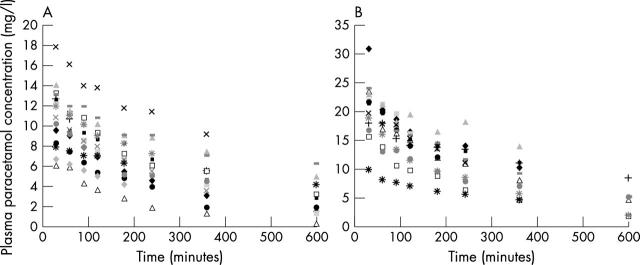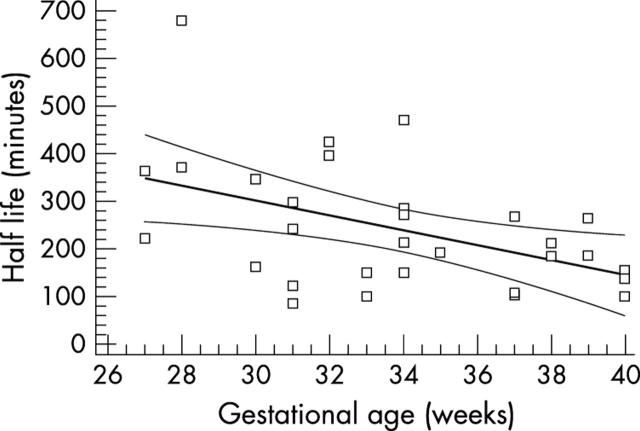Abstract
Aim: To investigate the pharmacokinetics and pharmacodynamics of single dose propacetamol in preterm and term infants on the first day of life.
Methods: Neonates were stratified by gestational age. Preterm (< 37 weeks) and term (37–41 weeks) infants received a single dose of propacetamol in the first 24 hours of life when they had minor, painful procedures or as additional treatment in infants receiving opioids. Blood samples were taken from an arterial line, and pain was evaluated by a multidimensional pain scale. Results were reported as mean (SD). Student's t and Wilcoxon tests were used to compare the groups.
Results: Thirty neonates were included, 10 of which were term infants. Serum half life was 277 (143) minutes in the preterm infants and 172 (59) minutes in the term infants (p < 0.05). Clearance was 0.116 (0.08) litre/kg/h in the preterm infants and 0.170 (0.06) litre/kg/h in the term infants (p < 0.05). Gestational age correlated with serum half life (r = -0.46). No effect of sex or administration of prenatal steroids was found on the pharmacokinetics of paracetamol. In neonates who only received propacetamol (n = 15), the level of analgesia seemed to be associated with the therapeutic (> 5 mg/l) level.
Conclusions: A correlation was found between gestational age and the serum half life of propacetamol. The maturational trend of clearance and half life in preterm and term neonates is in line with data on the pharmacokinetics of propacetamol beyond the newborn period.
Full Text
The Full Text of this article is available as a PDF (315.1 KB).
Figure 1 .
Plasma levels of paracetamol in all infants (n = 213) after a single intravenous administration of 20 mg/kg (A) or 40 mg/kg (B) of propacetamol.
Figure 2 .
Linear regression analysis (with 95% confidence intervals) of the effect of gestational age on serum half life (r = -0.46).
Selected References
These references are in PubMed. This may not be the complete list of references from this article.
- Allegaert Karel, Tibboel Dick, Naulaers Gunnar, Tison Denise, De Jonge Annick, Van Dijk Monique, Vanhole Christine, Devlieger Hugo. Systematic evaluation of pain in neonates: effect on the number of intravenous analgesics prescribed. Eur J Clin Pharmacol. 2003 Apr 4;59(2):87–90. doi: 10.1007/s00228-003-0585-3. [DOI] [PubMed] [Google Scholar]
- Ambalavanan N., Carlo W. A. Analgesia for ventilated neonates: where do we stand? J Pediatr. 1999 Oct;135(4):403–405. doi: 10.1016/s0022-3476(99)70156-3. [DOI] [PubMed] [Google Scholar]
- Anand K. J., Barton B. A., McIntosh N., Lagercrantz H., Pelausa E., Young T. E., Vasa R. Analgesia and sedation in preterm neonates who require ventilatory support: results from the NOPAIN trial. Neonatal Outcome and Prolonged Analgesia in Neonates. Arch Pediatr Adolesc Med. 1999 Apr;153(4):331–338. doi: 10.1001/archpedi.153.4.331. [DOI] [PubMed] [Google Scholar]
- Anand K. J., Hickey P. R. Pain and its effects in the human neonate and fetus. N Engl J Med. 1987 Nov 19;317(21):1321–1329. doi: 10.1056/NEJM198711193172105. [DOI] [PubMed] [Google Scholar]
- Anand K. J., International Evidence-Based Group for Neonatal Pain Consensus statement for the prevention and management of pain in the newborn. Arch Pediatr Adolesc Med. 2001 Feb;155(2):173–180. doi: 10.1001/archpedi.155.2.173. [DOI] [PubMed] [Google Scholar]
- Anderson B. J. What we don't know about paracetamol in children. Paediatr Anaesth. 1998;8(6):451–460. doi: 10.1046/j.1460-9592.1998.00295.x. [DOI] [PubMed] [Google Scholar]
- Anderson Brian J., van Lingen Richard A., Hansen Tom G., Lin Yuan-Chi, Holford Nicholas H. G. Acetaminophen developmental pharmacokinetics in premature neonates and infants: a pooled population analysis. Anesthesiology. 2002 Jun;96(6):1336–1345. doi: 10.1097/00000542-200206000-00012. [DOI] [PubMed] [Google Scholar]
- Arana A., Morton N. S., Hansen T. G. Treatment with paracetamol in infants. Acta Anaesthesiol Scand. 2001 Jan;45(1):20–29. doi: 10.1034/j.1399-6576.2001.450104.x. [DOI] [PubMed] [Google Scholar]
- Autret E., Dutertre J. P., Breteau M., Jonville A. P., Furet Y., Laugier J. Pharmacokinetics of paracetamol in the neonate and infant after administration of propacetamol chlorhydrate. Dev Pharmacol Ther. 1993;20(3-4):129–134. doi: 10.1159/000457553. [DOI] [PubMed] [Google Scholar]
- Barr Joseph, Brenner-Zada Galit, Heiman Eli, Pareth Gideon, Bulkowstein Mordechai, Greenberg Revital, Berkovitch Matitiahu. Unlicensed and off-label medication use in a neonatal intensive care unit: a prospective study. Am J Perinatol. 2002 Feb;19(2):67–72. doi: 10.1055/s-2002-23557. [DOI] [PubMed] [Google Scholar]
- Depré M., van Hecken A., Verbesselt R., Tjandra-Maga T. B., Gerin M., de Schepper P. J. Tolerance and pharmacokinetics of propacetamol, a paracetamol formulation for intravenous use. Fundam Clin Pharmacol. 1992;6(6):259–262. doi: 10.1111/j.1472-8206.1992.tb00119.x. [DOI] [PubMed] [Google Scholar]
- Hopkins C. S., Underhill S., Booker P. D. Pharmacokinetics of paracetamol after cardiac surgery. Arch Dis Child. 1990 Sep;65(9):971–976. doi: 10.1136/adc.65.9.971. [DOI] [PMC free article] [PubMed] [Google Scholar]
- Kennedy K. A., Tyson J. E. Narcotic analgesia for ventilated newborns: are placebo-controlled trials ethical and necessary? J Pediatr. 1999 Feb;134(2):127–129. doi: 10.1016/s0022-3476(99)70399-9. [DOI] [PubMed] [Google Scholar]
- Lin Y. C., Sussman H. H., Benitz W. E. Plasma concentrations after rectal administration of acetaminophen in preterm neonates. Paediatr Anaesth. 1997;7(6):457–459. doi: 10.1046/j.1460-9592.1997.d01-126.x. [DOI] [PubMed] [Google Scholar]
- Nolent P. Intramuscular injection of propacetamol in a neonate. Arch Dis Child Fetal Neonatal Ed. 2002 Sep;87(2):F155–F155. doi: 10.1136/fn.87.2.F155. [DOI] [PMC free article] [PubMed] [Google Scholar]
- Tenenbein M. Why young children are resistant to acetaminophen poisoning. J Pediatr. 2000 Dec;137(6):891–892. doi: 10.1067/mpd.2000.107624. [DOI] [PubMed] [Google Scholar]
- de Peyster A., Willis W. O., Liebhaber M. Cholinesterase activity in pregnant women and newborns. J Toxicol Clin Toxicol. 1994;32(6):683–696. doi: 10.3109/15563659409017975. [DOI] [PubMed] [Google Scholar]
- van Lingen R. A., Deinum H. T., Quak C. M., Okken A., Tibboel D. Multiple-dose pharmacokinetics of rectally administered acetaminophen in term infants. Clin Pharmacol Ther. 1999 Nov;66(5):509–515. doi: 10.1016/S0009-9236(99)70014-7. [DOI] [PubMed] [Google Scholar]
- van Lingen R. A., Deinum J. T., Quak J. M., Kuizenga A. J., van Dam J. G., Anand K. J., Tibboel D., Okken A. Pharmacokinetics and metabolism of rectally administered paracetamol in preterm neonates. Arch Dis Child Fetal Neonatal Ed. 1999 Jan;80(1):F59–F63. doi: 10.1136/fn.80.1.f59. [DOI] [PMC free article] [PubMed] [Google Scholar]




